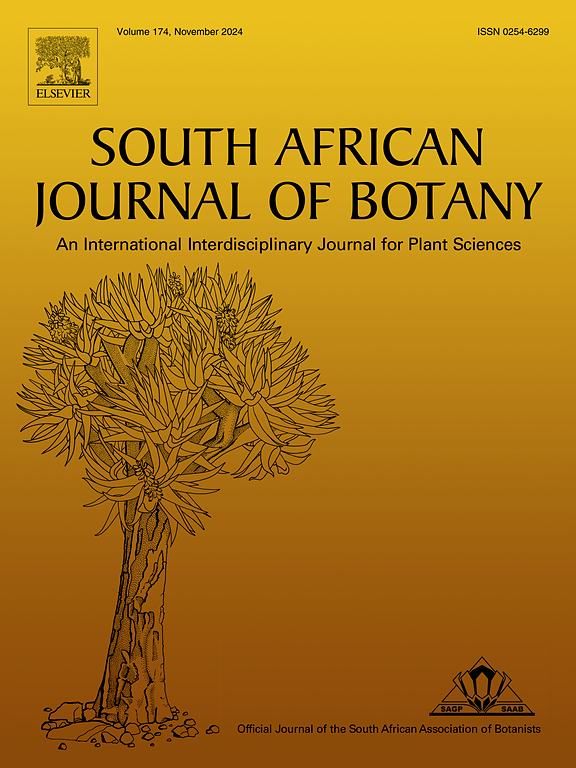Anti-acne and anti-hyperpigmentation potential of selected South African bryophytes with identification of oleamide as a lead compound
IF 2.7
3区 生物学
Q2 PLANT SCIENCES
引用次数: 0
Abstract
Acne vulgaris (AV), a chronic dermal inflammatory condition, affects approximately 9.4 % of the global population, with adolescents exhibiting the highest prevalence. Cutibacterium acnes is a key pathogenic factor in this chronic inflammatory condition, often resulting in post-inflammatory hyperpigmentation (PIH), which is primarily treated with tyrosinase inhibitors targeting melanin synthesis. While bryophytes are underexplored in modern cosmeceutical research, they have a history of use in traditional Chinese and Indian medicine for skin ailments. This study aimed to evaluate the antibacterial and anti-tyrosinase potential of three bryophyte species—Bryum argenteum Hedw., Fabronia pilifera Hornsch., and Leptodictyum riparium (Hedw.) Warnst.—to assess their utility in managing AV and PIH. Ethanolic (70 % v/v) extracts were prepared from rinsed and unrinsed plant material. Antibacterial activity against C. acnes (ATCC 6919) was assessed via PrestoBlue microtiter plate assays to determine the minimum inhibitory concentration (MIC) of the bryophyte ethanolic extracts. Tyrosinase inhibition was measured using colorimetric microtiter plate assays to evaluate anti-hyperpigmentation potential. Lead extracts were further analysed for their volatile constituents using gas chromatography-mass spectrometry (GC-MS). Rinsed B. argenteum extract exhibited the strongest antibacterial activity with an MIC of 31.25 μg/mL, followed by rinsed F. pilifera extract at 62.5 μg/mL. All extracts showed minimal tyrosinase inhibition, with IC₅₀ values exceeding the highest concentration tested. GC-MS analysis identified oleamide, a compound with known antibacterial properties, as the major volatile constituent (17.37 %–52.64 %), with the highest concentration of oleamide found in rinsed B. argenteum extract. These findings suggest that selected bryophytes, particularly B. argenteum, may serve as promising sources of antibacterial agents for the treatment of AV. Although pharmaceutically significant tyrosinase inhibition was not observed, the high oleamide content warrants further investigation through bioassay-guided fractionation. This study introduces bryophytes as novel candidates for cosmeceutical applications targeting acne-related skin concerns.

南非苔藓植物抗痤疮和抗色素沉着的潜力与鉴定的油酰胺为先导化合物
寻常性痤疮(AV)是一种慢性皮肤炎症,影响全球约9.4%的人口,其中青少年的患病率最高。痤疮表皮杆菌是这种慢性炎症的关键致病因素,通常导致炎症后色素沉着(PIH),主要用靶向黑色素合成的酪氨酸酶抑制剂治疗。虽然苔藓植物在现代药妆研究中尚未得到充分开发,但它们在传统的中国和印度药物中用于治疗皮肤疾病的历史悠久。本研究旨在评价三种苔藓植物——阿根廷bryum argentteum Hedw的抑菌和抗酪氨酸酶潜力。, Fabronia pilifera Hornsch。(hew .);Warnst。-评估它们在管理AV和PIH中的效用。从漂洗和未漂洗的植物材料中制备乙醇(70% v/v)提取物。采用PrestoBlue微滴板法测定苔藓植物乙醇提取物对C. acnes (ATCC 6919)的抑菌活性,确定其最低抑菌浓度。酪氨酸酶抑制用比色微滴板法测定,以评估抗色素沉着的潜力。采用气相色谱-质谱联用(GC-MS)进一步分析铅提取物的挥发性成分。银杏叶提取物的抑菌活性最强,其MIC值为31.25 μg/mL,其次是毛毛菌提取物,其MIC值为62.5 μg/mL。所有提取物都显示出最小的酪氨酸酶抑制作用,IC₅0值超过测试的最高浓度。GC-MS分析发现,油酰胺是一种已知具有抗菌性能的化合物,为主要挥发性成分(17.37% - 52.64%),其中油酰胺含量最高的是洗过的银白草提取物。这些发现表明,某些苔藓植物,特别是银芽甘蓝,可能是治疗AV的有希望的抗菌药物来源。尽管没有观察到具有药理意义的酪氨酸酶抑制作用,但其高油酰胺含量值得通过生物测定引导分离进一步研究。本研究介绍了苔藓植物作为针对痤疮相关皮肤问题的药妆应用的新候选人。
本文章由计算机程序翻译,如有差异,请以英文原文为准。
求助全文
约1分钟内获得全文
求助全文
来源期刊

South African Journal of Botany
生物-植物科学
CiteScore
5.20
自引率
9.70%
发文量
709
审稿时长
61 days
期刊介绍:
The South African Journal of Botany publishes original papers that deal with the classification, biodiversity, morphology, physiology, molecular biology, ecology, biotechnology, ethnobotany and other botanically related aspects of species that are of importance to southern Africa. Manuscripts dealing with significant new findings on other species of the world and general botanical principles will also be considered and are encouraged.
 求助内容:
求助内容: 应助结果提醒方式:
应助结果提醒方式:


